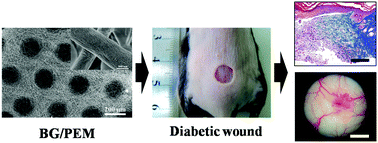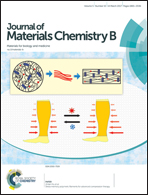A patterned nanocomposite membrane for high-efficiency healing of diabetic wound
Abstract
The highly efficient therapy of diabetic wounds represents a significant clinical challenge. To effectively stimulate angiogenesis and accelerate diabetic wound healing, we prepared a nanocomposite dressing that combined bioactive glass (BG) nanocoatings with a patterned electrospun membrane (BG/PEM) via a pulsed laser deposition (PLD) technique. The results showed that the BG nanocoatings had a homogeneous nanostructure and uniform elemental distribution including Ca, Si, and P. The surface hydrophilicity of the virgin PEM was significantly improved after the BG nanocoatings were deposited. An in vitro study showed that Si ions could be released from BG/PEM in a controlled profile. The proliferation, attachment, and expression of angiogenesis-related genes (endothelial nitric oxide synthase (eNos) and vascular endothelial growth factor (VEGF)) of human umbilical vein endothelial cells (HUVECs) on BG/PEM were significantly enhanced in comparison with those of the cells on the PEM. An in vivo study showed that diabetic mice wounds treated with BG/PEM had closed by nearly 80% at day 13, which is a significantly higher rate than that obtained with the PEM (57%) and control (56%) groups. Furthermore, wounds treated with BG/PEM displayed significantly improved efficiency in the stimulation of angiogenesis (indicated by CD31 expression and number of new blood vessels), as well as re-epithelialization. Overall, our results indicated that the BG/PEM nanocomposites were promising biomaterials for the rapid stimulation of angiogenesis and highly efficient healing of diabetic wounds.

- This article is part of the themed collection: 2017 Journal of Materials Chemistry B HOT Papers


 Please wait while we load your content...
Please wait while we load your content...